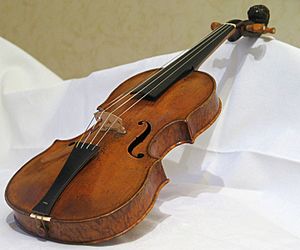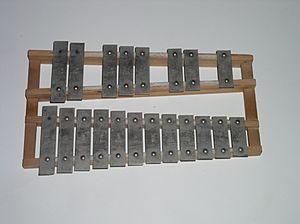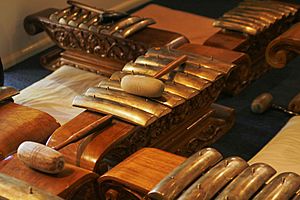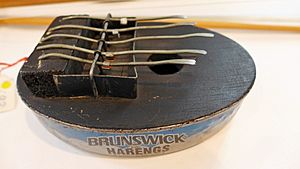Musical instrument facts for kids

Musical instruments are special tools used to make music. While almost anything that makes a sound could be called an instrument, this term usually means items specifically designed for creating musical sounds.
Musical instruments can be grouped into different types:
- String instruments: These make sound from vibrating strings. You can play them by plucking (like a guitar) or with a bow (like a violin).
- Woodwind instruments: These use air blown through a reed or across an edge to make sound (like a flute or clarinet).
- Brass instruments: These are made of brass and use air blown through vibrating lips into a mouthpiece (like a trumpet or trombone).
- Percussion instruments: You play these by hitting, shaking, or scraping them (like drums or cymbals).
- Keyboard instruments: These have a musical keyboard with keys you press to make sounds (like a piano or organ).
In an orchestra, you'll find instruments from four main families:
- Bowed string instruments (like the violin)
- Woodwind instruments (like the flute)
- Brass instruments (like the trumpet)
- Percussion instruments (like drums)
Some people even think the voice is a "natural musical instrument." This is because singing lets us make music without needing any other tools!
How Musical Instruments Are Made
The materials used to build musical instruments can be very different. It depends on the culture and what the instrument is for. Sometimes, the materials have a special meaning because of where they come from or how rare they are.
For example, mulberry trees are highly respected in China. Because of this, instrument makers often use them to create zithers, which are string instruments. The Yakuts people believe that drums made from trees hit by lightning have a special connection to nature.
Building musical instruments is a very skilled job. It often takes many years of training, practice, and sometimes even learning from an expert (an apprenticeship).
How We Play Instruments

No matter how an instrument makes sound, many of them have a musical keyboard as their main way to play them. Keyboard instruments are any instruments that you play using a keyboard.
Each key on a keyboard makes one or more sounds. Most keyboard instruments also have extra ways to change these sounds. For example, a piano has pedals, and an organ has stops and a pedal keyboard.
Keyboard instruments can make sound in different ways:
- Wind can be fanned (organ) or pumped (accordion).
- Strings can vibrate when they are hammered (piano) or plucked (harpsichord).
- Some use electronic methods (synthesizer).
Sometimes, instruments that don't usually have a keyboard are fitted with one. The glockenspiel is an example. Even though you hit its metal bars with mallets, the bars are arranged like a keyboard. This helps players understand how to make different notes.
The theremin is a very unique electronic instrument. You play it without even touching it! You move your hands in the air around its antennas to change the sound.
Images for kids
-
Anne Vallayer-Coster, Attributes of Music, 1770. This still life painting shows many French Baroque musical instruments. These include a natural horn, transverse flute, musette, pardessus de viole, and lute.
-
Found in Slovenia, the Divje Babe Flute might be the world's oldest known musical instrument.
-
An Ancient Egyptian painting from about 1350 BC. It shows people playing lutes.
-
The huge Bianzhong of Marquis Yi of Zeng, from about the 5th century BCE, found in Hubei, China.
-
The Duet, painted by Dutch artist Cornelis Saftleven around 1635. It shows a violinist and a cittern player.
-
Wolfgang Amadeus Mozart plays the keyboard while his father, Leopold Mozart, plays the violin.
-
Some early Fender brand electric guitars.
See also
 In Spanish: Instrumento musical para niños
In Spanish: Instrumento musical para niños
















